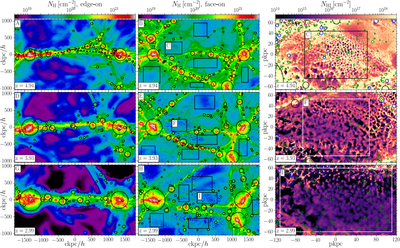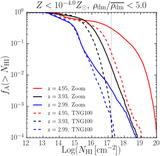Image Details

Caption: Figure 1.
Simulation zoom region at z ∼ 5 (top), z ∼ 4 (middle), and z ∼ 3 (bottom). The left and center columns show the large-scale structure surrounding the two main halos, which lie in a cosmic sheet shown edge-on and face-on in the left and center columns, respectively. The color scale indicates the total hydrogen column density, NH, integrated over ±400 h−1 ckpc. Black circles mark dark matter halos with virial mass Mv > 109M⊙, while their sizes denote Rv. Nearly all these halos lie along dense filaments within the sheet. The right column zooms in on the IGM regions marked with black rectangles in the center column, and shows the neutral hydrogen column density, NH I, integrated over ±30 pkpc at z ∼ 5 and z ∼ 4, and ±60 pkpc at z ∼ 3, roughly where the vertical gas density profile reaches the universal mean. Note the different spatial units in these panels. Black, blue, and green circles mark halos with Mv > 109M⊙, 109 > Mv > 108M⊙, and 108 > Mv > 107M⊙, respectively, their sizes denoting Rv. A collision between two initially inclined sheets at z ∼ 5 (dashed lines in panel (A)), produces a strong shock that leads to thermal instability in the postshock region within the merged sheet. This causes the sheet to “shatter” and produces a multiphase medium.
Copyright and Terms & Conditions
© 2019. The American Astronomical Society. All rights reserved.







